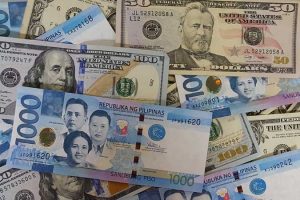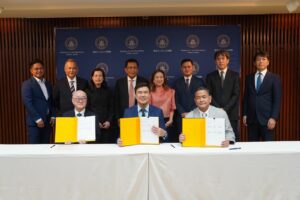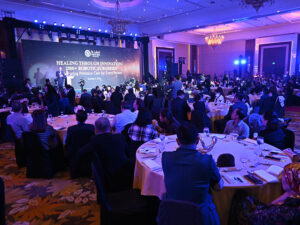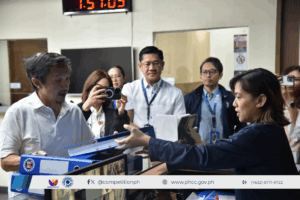THE PHILIPPINE PESO is expected to end the year stronger against the US dollar as the greenback remains under pressure due to US President Donald J. Trump’s continued attacks against the US Federal Reserve.
MUFG Global Markets Research said they expect the peso to rise to the P56 level in the coming months as global investors remain bearish on the US dollar.
“We have adjusted our PHP forecast slightly stronger and see USD/PHP moving towards the P56 levels (from P56.50 levels previously). The key reason for the forecast change is mainly global rather than local, with our G10 team now seeing more US dollar weakness with increasing concerns around President Trump’s attack on Fed independence,” it said in its Foreign Exchange Outlook report for September.
On Tuesday, the peso closed at P57.51 versus the dollar, plunging by 35 centavos from Monday’s finish of P57.16. This was its worst showing in nearly a month or since it ended at P57.63 against the greenback on Aug. 5.
Year to date, the local unit is still up by 33.5 centavos or 0.58% from its end-2024 close of P57.845.
According to its latest forecasts, the research firm expects the peso to close this quarter at P57 versus the dollar and strengthen further to end 2025 at P56.50. It sees the local unit then rising to P56 against the greenback in the first half of 2026.
MUFG Global Markets Research said concerns over the Fed will continue to be a key focus for investors.
“The decision of President Trump on Aug. 25 to fire Fed Governor Lisa Cook has dramatically escalated the risks associated with threats to Fed independence… Whatever the outcome, it is clear that Mr. Trump is willing to act aggressively and that to us underlines the need for investors to price this risk into US assets. The financial market indifference so far is unlikely to last and this is likely to be a prominent theme throughout the remainder of Trump’s term in office… We have therefore lowered our US dollar forecasts to reflect these increased risks,” it said.
Mr. Trump has been exerting relentless pressure on the Fed to cut interest rates and publicly discussed firing Fed Chairman Jerome H. Powell, whom he called a “numbskull” and a “moron,” for not giving in to his demands, Reuters reported.
Upping this battle, Mr. Trump last month attempted to fire Ms. Cook, setting off a critical legal test over the Fed’s ability to function without political interference, the cornerstone of modern central banking.
Mr. Trump is demanding lower rates to boost investment and give mortgage borrowers relief over some of the highest interest rates in the developed world.
But politically motivated rate cuts would signal that the Fed is willing to tolerate higher inflation, eroding trust among investors, who hold trillions of dollars of US assets, banking on policy certainty from the Fed.
Such a loss of confidence could then push up longer-term borrowing costs, which are more relevant than short-term central bank rates for mortgages and business loans, potentially undoing any Fed effort to ease the financing burden.
Philippine Institute for Development Studies Senior Research Fellow John Paolo R. Rivera said that while Mr. Trump’s continued efforts to undermine the Fed could weigh on the dollar and benefit the peso and other emerging-market currencies, this may not be felt unless the market sees “concrete Fed policy shifts or political pressure affecting rate cuts.”
“For now, the peso remains anchored near P57 due to cautious investor sentiment and persistent trade and fiscal pressures. A sustained shift to P56 level would require both global US dollar weakness and improved local macro signals, including moderating inflation and consistent FDI (foreign direct investment) or remittance flows,” Mr. Rivera said.
DOMESTIC SUPPORTMUFG Global Markets Research likewise said that the peso will be supported by a broadly positive economic environment.
“From a domestic perspective, many of the positive factors we mentioned have not changed, and as such, we remain comfortable in our view for PHP to strengthen modestly against the dollar,” it said.
Inflation is expected to remain benign amid modest rice prices and “low upside risks” to transport and electricity costs, it said.
“The recent temporary ban on rice imports is a key risk, but with domestic rice inventories still high, the impact should be manageable.”
Philippine headline inflation averaged 1.7% in the first seven months, well below the Bangko Sentral ng Pilipinas’ (BSP) 2-4% annual target and matching its forecast for the year.
Rice inflation has been decelerating amid the government’s measures to curb rising prices of the staple, including lowering tariffs.
The 60-day suspension of rice imports started on Sept. 1 and will end on Oct. 30. It covers imports of regular milled and well-milled rice but excludes varieties that are not commonly produced locally.
It added that it sees the BSP cutting benchmark interest rates by 25 basis points (bps) again in the fourth quarter to bring the terminal rate to 4.75%.
The BSP last week cut the target reverse repurchase rate by 25 bps for a third straight meeting to 5%. It has now slashed borrowing costs by a total of 150 bps since the start of its easing cycle in August 2024.
BSP Governor Eli M. Remolona, Jr. said the latest move puts the policy rate at a “sweet spot” in terms of both inflation and output, signaling that the central bank is nearing the end of its rate-cut cycle.
Still, he left the door open to one last reduction within this year to support the economy if needed.
“Second, we expect actual FDI to improve, reflecting the surge in FDI approvals already seen especially in the renewable energy space,” MUFG Global Markets Research said. “Third, the pipeline of public and private infrastructure projects remains strong.”
It added that the effect of the 19% “reciprocal” tariff rate on Philippine exports to the US is to be minimal as the levy was mostly at par with those slapped on competitors, and with the economy being domestic oriented.
“Details of upcoming sectoral tariffs on semiconductors will nonetheless be important for the Philippines’ exports given the country’s focus on lower value-added testing and assembly activity.”
Mr. Trump has threatened to impose a 100% tariff on semiconductors.
In June, the United States was the top destination for Philippine-made goods amounting to $1.22 billion, 35.2% higher from the same month a year ago. Around 53% of the Philippines’ total exports to the US were semiconductors and electronics. — BVR with Reuters and a report from K.K. Chan






